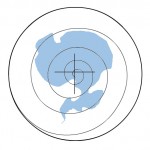
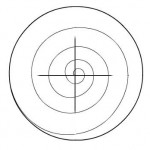
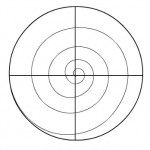
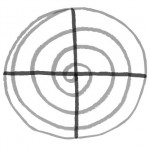
In the animation, Insights, the circle, the spiral and the cross were combined to identify physical structures within the Antarctic environment: bottom water circulation, the circumpolar current, and the southern pivot point of the earth’s rotation. To some people these forms represent the telescopic cross hairs in a rifle, and the spiraling thread within a rifle’s barrel. They can therefore evoke feelings of death and destruction. To others these same forms can evoke feelings of unity , wholeness, and new growth.
As comments on the image and the animation have arrived, I have learned what thoughts and feelings have been conveyed through them. After reading these comments and reflecting on the ideas and feelings I intend to convey, I have made some changes.
My aim is to convey an idea of how Antarctica works as a system to replenish life on earth, and a feeling of hope about our ability to reduce our harmful impact on the environment.
The animation was inspired by encounters with people and places, and with works of art and science that identify humanity as part of a living world.
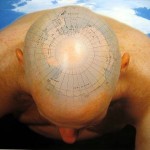
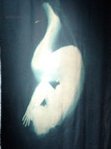
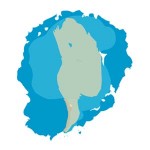

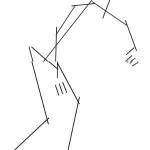
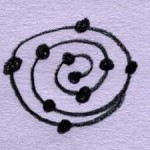
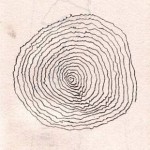
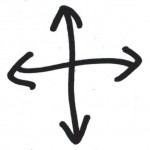
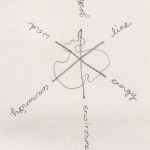
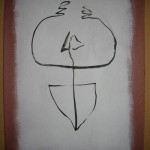

Heresay and Fact: the Ginko trees of Antarctica
Perhaps such gestures and lines as these were used by humans before speech, to convey knowledge about environments (Corballis, 2009). As infants our knowledge of environments came through touch. Such early evolutionary and developmental memories have been identified by Freud the ‘archaeology of the mind’, and as the ‘Old brain’ by artist Len Lye (Burke, 2008; Cantrill, 2002).
In Antarctic Animation, the circle, the spiral and the cross function as metaforms. Here, a metaform is defined as a gesture or line that conveys both subjective and objective knowledge. Depending on the experience of the viewer, they will coney different meanings.
The Shorter Oxford English Dictionary (OED) (1973, p. 1313), defines the chief senses of the Greek prefix, Meta, as ‘sharing, action in common; … change (of place, order, condition, or nature)’.
In Antarctic Animation, the circle, spiral and cross share objective and subjective meanings. These meanings, however, are not fixed. On the contrary, these forms are combined to represent an evolving, collective, body of knowledge.
One meaning given for the word, ‘Form’, is ‘a body considered in respect of its outward shape’, especially that of a person. Kant is also cited as defining the word, in 1803, as ‘The (subjective) factor of knowledge which gives reality and objectivity to the thing known’ (1972, p. 272).
In Antarctic Animation, the gesturing human form is used to evoke empathic, kinesthetic knowledge of Antarctica. Through its gestures, the human form ‘gives reality and objectivity to the thing known’, where ‘thing known’ is a feeling. Like the poet, Vincent Buckley (Exiner & Kelynack, 1994, p. 31), I distinguish feeling from emotion:
The difference between emotion and feeling would seem to be that the former is simply a temporary response to experience, while the latter is something by which the person becomes attached to actuality. It is thus both a WAY of experiencing the actual world, and a capacity for keeping that experience constant.
Feelings conveyed though Antarctic Animation reflect world views of people who have connected through their senses to Antarctica. Such views were identified as more constant than emotions. Animations were made to reflect both physical and imagined connections of this kind.
Animations that simulate the act of drawing (drawing gestures) appeal to one’s ability to kinesthetically recall what is being observed (Watts 1977). In other words, as you watch the lines appearing, you may imagine yourself drawing.
Hand-drawn and digital lines were both used to evoke different ways of reading Antarctica: through conscious, linear thoughts, and through unconscious, spatial, sensory engagement.
To evoke linear, sequential thoughts, digital line drawings are accompanied by written words. Written sequential thoughts are consciously continuous.
Unconscious feelings and ideas are characteristically discontinuous. However, drawing is a way to trace connections between these. Line drawings trace spatial, rather than linear patterns. Hand-drawn lines also evoke a visceral, or physical response. A visceral response can trigger unconscious feelings and ideas.
Daniel Chander (2005) cites Anthony Wilden (1987, 222) declaring that, ‘no two categories, and no two kinds of experience are more fundamental in human life and thought than continuity and discontinuity’, and that these experiences of the world are reflected in analogical and digital representations.
Chander proposes that
We have a deep attachment to analogical modes and we tend to regard digital representations as ‘less real’ – at least initially … The analogue/digital distinction is frequently represented as ‘natural’ versus ‘artificial’. Perhaps this is connected in part with the notion that the unconscious – that which we regard as ‘deepest’ within us – appears to operate analogically (Wilden 1987, 224). The privileging of the analogical may be linked with the status of the unconscious and the defiance of rationality in romantic ideology (which still dominates our conception of ourselves as ‘individuals’).
Because Antarctic Animation is an on-line work, compiled using digital media, its gestures and lines are digital. However, both digital (software) and analogue (pencil) tools were used to made hand-drawn line animations. Because much of the work was hand-drawn frame-by-frame, a visceral sensation of drawing is conveyed. These animations trace human gestures that were performed in a physical space.
The animation, Insights, represents a coming together of places, people and ideas. As an animated gesture, it combines insights that were gained through encounters with many places, people and ideas.
The spiral represents dynamic forces that drive biological and environmental change. It also represents growth and transformation.
The circle represents the Antarctic environment as a meeting place for sharing knowledge. As a continent of science, Antarctica attracts many nations to explore our place in the world.
The cross marks the one grounded pivot point of the spinning earth. It also represents a convergence of ideas. It represents the convergence of different kinds of knowledge that combine to reveal Antarctica as a conveyor of global change.

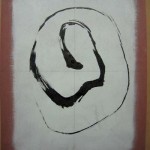
Hi Lisa – I think that I can only respond from a human movement perspective.
I saw the drawing as a part of the Dimensional Cross of Axes from Laban’s area of Space, but missing its 3 dimensionality.
It only has Vertical and Horizontal dimensions and misses the Sagittal component. The curves of the spiral are in direct contrast to the straight and stark lines of the cross. These are opposites in
line with many of his themes and Efforts – and their continuums. Straight versus curved pathways. I like the idea of the spiral representing ‘dynamic forces that drive biological and environmental change’ and / or ‘representing growth transformation’. A spiral , in movement terms is the most advanced form of Shaping/relationship available to us all as opposed to the straight line which is the most simplistic.
Just my reaction – not sure whether or not this is helpful to you.
Your feedback is helpful Jane. I am so used to working in the 2D, ‘drawing’, environment that it is sometimes easy to forget the saggital plane.
Karin Bond observed, years ago, that my animated figures dance in a weightless world. This stimulated ways to represent weight, through varying line thickness, for example.
Dancers have different eyes!
Dear Lisa, Your spiral, pulsing and subtle drew me into a feeling state. Static as the cross is, always distances my sense of feeling, which seeks movement. The two qualities of the spiral/ cross in bold and fine, do open up the dynamics and feelings of opposites which manifests itself in what you are writing about.
The cross is strong and somehow overpowers the life of the spiral in my feeling.
I think animation is a perfect medium for you to be exploring the essence of such an incredible land as Antarctica. You have such animation in your being and in your exploration of Antarctica and you truly are bringing together places and people and ideas. I love being part of your spiraling network of creative life and originality.
I am excited by you including feeling and emotion. The word for feeling in Indonesian coming from sanskrit is rasa, and that is what I sense Animating Antarctica gestures to. Rasa can mean both “feeling” and “meaning” According to Clifford Geertz ” the Religion of Java University of Chicago 1960 p.238-9 “whatever lives feels and whatever feels lives. Rasa can be “ultimate significance”- the deepest meaning at which one arrives by dint of mystical effort and whose clarification resolves all the ambiguities of mundane existence.
What a magnificent quest to find the essence through spiral and cross in your animation. Thank you for keeping in touch. Love Ellin
Hi Lisa,
Following are the notes I wrote as I watched
growth cycling
aim heavy
attention to centre
wide line soft on
edges
joining
fading
fine line, is it the same
repeated?
oh darker
+ distorts changes
spiral
focus
words make spiral a
symbol
is it a circle it closes
stops
focuses. oops fading yes
I can see circle
breathing slowed
beginning of spiral breathing fast
breathing slows towards the end
Christine,
Yes, I agree absolutely, that ‘words make spiral a symbol’.
Furthermore,
Symbols appeal to minds.
Gestures appeal to senses.
This commentary refers to the artist’s website lisaroberts.com.au, the Antarctic Animation creator and her Email to me. Sounds confusing? She invited me to paste my email in here.
ooooooooooooooooooooooooooooooooooooooooooooooooooooooooooooo
Interesting looking at history [and your history -herstory]. Glen Waverley 1964: Australia’s greatest oil field starts flowing in the Bass Strait. And now its almost empty as we rush up to Copenhagen.
It’d be good to have some optimism about this conference but fear it to be an excuse for governments to not do anything of significance, and oppositions to feel justified in their conservatism.
And what is the real conservatism?
In 1963, agreement reached for the Americans to establish a navel communications base on the North West Cape. I feel a certain Mr Curly influence in some of your works and feel he would be delighted with that rather than the naval base that was built.
1970 – The Female Eunich was a wonderful wedding present.
Love the drawing by Lillian Williamson – 1961 Drain pipes swallow up the creek. Yabbies and frogs disappear. Wonderfully chosen.
Learning to skate is like learning to fly: 1959. 1952: Douglas Adams was born and DNA discovered. Adams quote on flying which could be of import to skating: when you are about to hit the ground, miss.
1953 Wimmera atomic bomb tests, and I was born.
But I stop and check my spelling and find it should be spelt Woomera. From google: “Wimmera Catchment Management Authority is responsible for creating a healthier and more sustainable environment. We work in partnership with the Wimmera … http://www.wcma.vic.gov.au/”
[http://www.sea-us.org.au/thunder/britsbombingus.html] “Britain detonated its first nuclear device, Hurricane, on Monte Bello Island on October 3, 1952, followed by tests on May 16 and June 19, 1956. The June blast had a 60 kiloton capacity. At one monitoring point, over 3,200 kilometres to the east, radioactive iodine concentrations increased a hundredfold. Playboy magazine talked about this in the 1980s.
Two further atomic bomb tests, Totem 1 and 2, were carried out at Emu Field [Woomera Prohibited Area] on October 15 and 27, 1953. The next series of atomic bomb tests were carried out at Maralinga between September 27, 1956 and October 9, 1957, along with a series of “minor” trials up to 1963. The Grapple series of tests were undertaken at Malden and Christmas Islands May 15, 1957, to September 23, 1958. [and now Christmas Island is a refugee camp]
During the mainland tests many army personnel were deliberately exposed to the blasts just to see what effect radiation had on troops [just like Nazi experiments]. Security at the test sites was lax. The testing range boundaries were not properly monitored, allowing people to walk in and out. Any signs were in English, which the local Aboriginal population could not read. Fallout from the ground blasts led to massive contamination of the Australian interior. The fallout from Maralinga even reached Adelaide and Melbourne. [and back to Playboy, it talked about radiation in Central Qld cow’s milk]
Maralinga is Pitjantjatjara Aboriginal dialect for Field of Thunder.”
And I go overboard in replying to your email. But twas early Sunday morn when I started reading your website. I am now visualising Wilson Tuckey singing, “To wonderful wonderful Copenhagen, friendly old queen of the sea.” And he is accompanied by Senator Xenophon.
The animation evolves as I act upon the insightful comments that arrive!
My linguist fried, Bryan Fricker, suggests:
Antarctic expeditioner and scientist, Bill Burch, has inspired me to link this animation with the 350 message.
See Antarctic 350.
See 350.org
Dear Lisa,
The face broken by the wide-brushed arrow and 350 evokes a bodily response of tearing and separating, limbs of my body pulling apart. With the final words (”Antarctica is melting”) I could imagine (I wished to see) a figure dancing behind them, curving forward, bowing to the inevitability, strong at her centre for as long as the core rock remains.
In my dance the giving over, the relinquishment is as vital as the core stability, and vice versa; one without the other is flat and one-dimensional.
This is inspired in me by your drawings. Thankyou.
Jennifer De Leon (Dancer)
Dear Jenny,
Could this be the figure you imagine?
This is a frame from the animation, Windgathering, of a gesture made by the artist, Rena Czaplinska. Her gesture was made as an imaginative response to Antarctica. I used points and lines to trace, frame-by-frame, over a video recording of her spiraling motion. In this way I aimed to convey, as accurately as possible, her original ‘inner impulse’.
Lisa, I only realized a few months ago that I had been living what I had been trying to discover in bullroarers–consciousness as spiralling-spinning intelligent energy.
Then, I discovered an old book by D. A. Mackenzie, The Migration of Symbols, and found a treasure trove of spiral and cross symbols across human existence. You are awakening an archetypal giant with this project.
I am using massive spiraling sea and air currents in my book draft, though I did not use Antarctica! I love the idea that it might just be a midbrain!
And am including whirlpools sucking tiny animals. All of the powerful creative energies–tornadoes, whirlwinds, the spinning of Earth or the Milky Way, the growth of vines, the call of the bullroarers. . .I have a list now of at least a hundred spirals–manifest the same propelling energy of conscious intelligence. I try not to put “good” or “bad” on it, because the energy is in many ways so mechanically predictable.
Your cross-hairs of a rifle analogy really got to me. Almost the way a swastika is also the cross of Calvary or the heart of a labyrinth.
Thanks so much for this imagery. Bethe
Allo Lisa,
Ton animation, tout en lignes captive mon attention. La croix en trait plus épais apparait quelques secondes comme un fantôme, après que tu l’ais fait disparaître. Je trouve cet effet des plus intéressants. Aussi, la forme de l’antarctique dans la silhouhette d’une tête vide, comme si tu disais que le monde nous porte, mais que nous portons aussi le monde en nous. Si tu mets l’image de l’Antarctique dans la tête, est-ce parce que tu crois que notre relation au monde, à l’Antarctique est rationnelle? Aussi, les traits noirs sur fond blanc font plus penser à un univers rationnel. Pourtant dans le texte qui traite de ta démarche artistique tu parles de sentiments et d’émotions? C’est là un témoignage de la pensée écologiste.
Voilà Lisa mes commentaires bien spontanés après avoir visualisé 2 fois ton animation. Merci de me demander mes commentaires.
Au plaisir!!
Lorraine Beaulieu, Juin-Juillet, 9 October 2009
Dear Lisa,
I love the concepts and the symbols explained. The spiral also reminded me of sea shells and especially the base of the Tasmanian Winkle Shell. They make fab collages and shell necklaces also a tasty shell fish gourmet dish, but harder to find on our forshore these days.
It also felt natural to have the spiral develop in a clockwise motion. I think that is also the same direction for ‘low pressure systems’ in Southern Hemisphere. I guess the spinning point of earth also moves over decades or centuries, hence the quest for the point of most isolated Magnetic South Pole (1909-1980) which is written in our Antartic Literature.
Graeme, Librarian, AAD
Dear Lisa,
Thank you for the opportunity to comment on your Antarctic animation Insights. As usual the simplicity of your work belies the complexity of the issue you are illustrating or the depth of thinking that has gone into its construction. After watching the animation I sat here contemplating the work – then watched it again. I was left feeling what I initially thought was ’empty’, but upon reflection what I feel is ‘bereft’. The poignancy of your final line “Antarctica is melting” and then the image fading away is a powerful way to conclude. Is it possible for the image to fade more slowly? A sense of hope perhaps?? I’m also slightly bothered by the reference to cross-hairs of a rifle – this doesn’t seem to fit – but maybe that’s my own ignorance of the wider issues. I also agree with one of the comments about the cross marking a place rather than a space (X marks the spot) … and so perhaps being slightly less obtrusive in the image. This is a work that has piqued my interest in the wider issues into which you delve so fearlessly.
Hope to catch up soon,
Sharon
After reading these these insightful responses to the animation, Antarctic350, I have made some changes:
The first hand-drawn cross has been lightened in tone, so that its rigid form does not interrupt the flowing motion of the spiral so much.
To suggest the replenishing effect of Antarctic ‘bottom water’ circulation, the second, more finely drawn cross now emerges from the centre.
The words, ‘A cross marks a space to reflect on our place’, have been replaced by ‘A cross marks a place to meet and reflect’.
To suggest that humanity can achieve 350 parts per million of carbon in our atmosphere, Antarctica fades away more slowly.
I think the picture is quite clever together with the explanation.
My own immediate interpretation with the cross is that it’s a
crosshair, implying that Antarctica is “in the sights” of a
threatening force.
My only critique is that if someone didn’t have a caption, it would
be hard to work out that it relates to Antarctica. I wonder if there
could be some experimentation with the spiral to map out the
continent’s shape.
Thanks for your response Cameron.
Your idea of incorporating the shape of Antarctica within the circle is very good. Why didn’t I see that? Perhaps I couldn’t see the woods for the trees, as they say.
I have ‘slept’ on this image over several nights now and will work more on it. It would seem, from the responses, that it has potential, but is not quite there yet.
The animation and the image do not quite accord with my feeling, which is more positive!
I can see, for example, how the second cross, that now radiates from the centre (to indicate replenishment) may be made with several lines. It could be more like a star with many points. It could even twinkle!
As Sharon said, she came away from watching the animation feeling ’empty’ and ‘bereft’. There needs to be something living left to watch.
Jennifer’s desire to see a dancing figure at the end would seem to reflect that desire.
It bothers me, too, that ‘Antarctica’ is melting’ sounds so, when it is simply a fact. Yes, more snow is falling on the ice cap right now, as more condensation is created because of global warming. However, we are heading into the next ice age. This is part of the natural cycles of change, determined by our position in relation to the sun – as described by Milankovitch. What is not natural is the rate of greenhouse gas emissions (methane, CO2 and others) that humanity has added to the atmosphere.
Concentric circles radiating outwards from the centre is a moving image I woke with this morning, like the ancient limnal lines drawn in rock by ancient humans, to identify spaces between known and unknown places.
We do not know the effect than human-induced greenhouse gas emissions is having on the natural astrological cycles of change. It’s too complex for any one person to know. But my feeling is that is that there is hope, and so I will work on this small animated gesture to express that.
It’s important for me to know how others read this image and animation.
Your comments help me to understand, and to feel, which are both necessary to make images that communicate.
Thanks!
Hi Lisa!!
Fabo stuff there!
I see the spiral of new hope and growth and of new life with the wildlife. I see the spiral as our Earth, ever moving and changing. The circle is for me, never ending friendships that have no beginning and no ending and the cross as the meeting point of all the scientists who love our continent of Antarctica enough to care and want to do something constructive, in one central meeting point, Our ice, our home.
Hmmmm! Deep!
Jenna x
On Thu, 29 Oct 2009 15:17:21 +1100
Barbara Weiss wrote:
Hi Lisa,
Here are some thoughts on your Antarctic animation.
I love your animation of the spiral, of seeing the spiral being
drawn/ created. The delineation , of varying thicknesses, moving
sometimes fast, sometimes slowly, is as though gathering in more
information, contending with/absorbing things on the way before
moving on. The movement of circling remains constant, but is
gathering in, expanding as it transforms. The spiral is intrinsic to
dance. I see it as central to life, to growth and transformation.
The spiral can also be contracting. When the spiral/circle is
crossed it becomes for me a bull’ eye – a target – which in relation
to Antarctica’s future underlines its extreme vulnerability. The
cross visually freezes the spiralling process. The focus is sharp, as
it needs to be. Here, your depiction gives a telling picture of the
power of climate change – how it can have such alarming negative
impact, but can also give a hopeful, healing light to the process.
Hi Lisa,
Thanks for this beautiful animation – very peaceful with an edge of foreboding. We’ve just had 150 kangaroos culled from the top of Mt Panorama here in Bathurst ahead of the V8 car race, so the cross-hairs made me think of the shooter’s rifle sight. V8 car races, fossil fuel guzzling, carbon dioxide in the atmosphere, melting Antarctica… then on October 24, a group of us gathered at the Farmers Markets to join the international 350 campaign. Here’s a photo of our action as it was seen in Times Square, New York.
http://www.facebook.com/photo.php?pid=2837115&l=16ef4c6a20&id=656693444